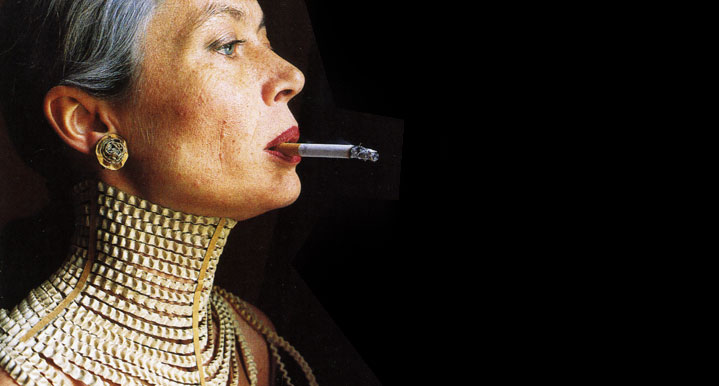Sunday, 12:00am
25 May 2008
Shameless
Hans-Peter Feldmann’s latest book celebrates the art of smoking

Web-only Critique written exclusively for eyemagazine.com
As a non-smoker I am probably in a minority when I admit to feeling a twinge of sympathy for smokers. No matter how careless they have been over the years about the effects of their habit on others, the sight of smokers being hounded out of their offices, eating places and even pubs and cafés, forced to congregate outside in little huddles of persistent offenders feels just a mite repressive and unfair. The health implications of smoking now dominate discussion, as they certainly should, and determine our increasingly intolerant view of the activity. But this doesn’t give us the whole story about smoking. Nor does it mean that, when the last remaining smokers have stubbed out their final cigarettes, nothing of any value will have been lost.
In the current anti-smoking climate in Britain and the US, many might be inclined to dismiss German artist Hans-Peter Feldmann’s latest project, published by Walther König in Cologne, as a piece of undisguised, unacceptable, pro-smoking propaganda. Smoke shows nothing other than photographs of smokers. There are no captions to say who took a picture, or who is shown, or when it was taken; the hardback volume, though recently published, is undated. The only text appears on the title page where Feldmann thanks all the photographers. As with his previous publications based on found photographs, it seems safe to assume that no permission to use the pictures has been sought or granted. The odds are equally high that Feldmann himself is a smoker.
Think of Edward Steichen’s The Family of Man reconceived for nicotine addicts. Spanning the twentieth century, the pictures reveal a not-so-distant world where smoking was taken for granted as entirely normal, even desirable, and anyone could join in: men, women, lovers, leisure-takers, musicians, miners, writers, topless dancers, the elderly, pregnant women, and children, who handle the deadly tubes like naturals. A uniformed doctor puffs away as he administers eye-drops to a young boy; a trendy vicar with a Zapata moustache blows a smoke ring like a halo above his head; and a spaced-out hippie puts his arm around his girl’s shoulders as she takes a long drag.
The famous people – Chet Baker, Carson McCullers, Jean Genet, Jean-Paul Sartre, Jane Birkin, Leonard Cohen and Nick Cave – rub along here with the ordinary folk on equal terms. Feldmann pairs the pictures with an art director’s flair for size, scale, pacing and visual relationships. If a woman’s eye looks out at us in one photo, in the picture opposite the subjects’ eyes will be hidden, while in each of these scenes the cigarette seems almost incidental to the main event – posing in a hat or kissing.
Smoke has nothing to say about the health risks, but as a social and psychological study it’s acute. This miniature wand allows endless opportunity to display character. It provides a pretext to wave the hands about like no other, and smokers’ arms relax into an endlessly expressive variety of poses and shapes. It’s impossible to imagine even such everyday objects as drinking glasses or pens eliciting the same wealth of gestures and postures, or that photographers could find them so compelling to study.
Solitary smokers tend to look poised, peaceful, at home in the moment of smoking, the act of inhalation encouraging states of inwardness and reflection. But smoking is inherently social and the pictures also capture the bonding rituals of lighting up: heads hunched over a burning match, the delicate transfer of fire from one tip to another. Most people hold a cigarette between the first two fingers, so what makes a few individuals prefer the finicky precision of finger and thumb? Even the clouds that wreathe and obscure these smoke-fiends can become signs of character, dribbling ectoplasmically from the lips, or expelled like cones of hot exhaust from the nostrils.
What might seem striking to us now is their lack of shame. These smokers are happy to be photographed in the throes of their addiction, not that they would see it like that. They instinctively know that, by giving them something to do, the cigarette removes the awkwardness of posing, and they are bound to look good. No one would hold up a biro, allowing it to co-star in her portrait, yet the slender white cylinder in the beautiful woman’s hand looks like it was meant to be there in the shot, and something would be missing without it. Perhaps it seems hard to credit now, when so many hate the habit with a passion, but the act of smoking, the way people smoke, reveals their humanity. Smoking was always about a lot more than mere smoke, and that is the part we can’t replace. This pungent celebration is enough to make you reach for the fags. Almost.
Rick Poynor, writer, founder of Eye, London
Eye is the world’s most beautiful and collectable graphic design journal, published quarterly for professional designers, students and anyone interested in critical, informed writing about graphic design and visual culture. It is available from all good design bookshops and online at the Eye shop, where you can buy subscriptions and single issues.